Lets see how Royal Purple's moly based lubricant technology has performed over the years. To test lubricant performance, we use ASTM D-4172, the industry standard testing methodology to determine wear protection of a lubricant.
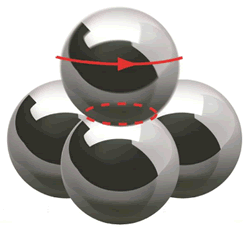 Four-Ball Wear Test (ASTM D-4172) evaluates the protection provided by engine oil under conditions of pressure and sliding motion. The size of the scar left as a result of the test determines the amount of wear protection the lubricant provides. The smaller the wear scar, the better the protection.
Four-Ball Wear Test (ASTM D-4172) evaluates the protection provided by engine oil under conditions of pressure and sliding motion. The size of the scar left as a result of the test determines the amount of wear protection the lubricant provides. The smaller the wear scar, the better the protection.
Our 2005 test results show nearly 2 times wear scar when compared with Royal Purple 20W50 to AMSOIL Series 2000 20W50 Racing Oil (TRO). In fact Castrol Syntec & Mobil1 Extended Performance 15W50 marginally outperformed Royal Purple.
In 2008 AMSOIL replaced the Series 2000 20W50 Racing Oil with AMSOIL Dominator® Synthetic 15W-50 Racing Oil (RD50). When the new formulation was put to the test, the results indicate 3 times better wear protection compared to Royal Purple 20W50 when AMSOIL RD50 is used.
2008 ASTM D-4172 test results (see below) reveals that Royal Purple 5W20, 5W30 & 20W50 causes nearly 3 times the wear scar when compared to AMSOIL Dominator® Synthetic Racing Oils RD20 5W-20, RD30 10W-30 & RD50 15W50 respectively.
In 2013 AMSOIL compared Royal Purple along with 9 other brands. For full report refer, 2013 synthetic oil comparison test results page
In 2016 AMSOIL again subjected Royal Purple 5W30, Mobil1 Extended Performance 5W30 and AMSOIL signature series 5W30 to ASTM TEOST 33c test and found AMSOIL to be 3.6X better than RP and 4X better than Mobil1 EP. For details visit 2016 5W30 Oil Comparison TEOST 33c Results page
Now let's see what is behind Royal Purple formulation & how the technology compares with AMSOIL, which has half the wear scar as Royal Purple.
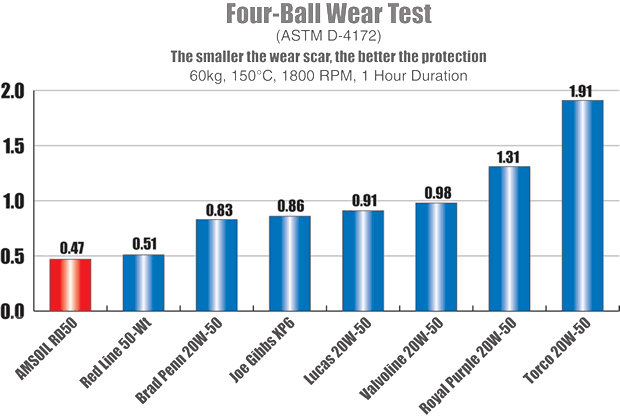
As you may know, Royal Purple is well known in racing circles. The chemistry they use is something AMSOIL, Inc. chooses not to use. One of their big selling points is extended drain intervals. Some additive chemicals can cause adverse conditions when used for long periods.
Royal Purple uses a different chemistry than most oils. They are one of only a handful of marketers using Molybdenum Disulfide (Moly) in their oil. Moly is a solid material, which is specifically banned by Cummins®, due to excessive valve train wear.
Moly is a processed mineral that is similar in appearance to graphite. Moly has good lubricating properties when used either by itself (in dry powder form or as an additive to oil or other lubricants). Particles of the Moly can come out of suspension and agglomerate. This can actually clog oil filters or oil lines and the rest normally settles in the bottom of the oil pan. This seems to be more likely when using extended drain intervals. In 2005, the test we ran on Royal Purple involved their 20W50 Racing oil versus our AMSOIL Series 2000 Synthetic 20W50 Racing Oil (TRO).
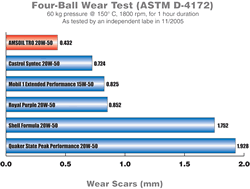 In 2005 we ran two 4 ball wear tests with different parameters, a spectrographic baseline, FTIR scan and volatility tests. The Royal Purple showed a significantly high volatility rate with a 12.51% boil off rate. This compares to the AMSOIL TRO with only 4.47% volatility rating. Wear scars were also
smaller with the TRO. For example the AMSOIL TRO left a .432mm scar and the Royal Purple oil left a .852mm scar. The lower the scare damage number the better! There was also a surprising difference in the viscosity index. The Royal Purple viscosity index (VI) recorded a low 129 cSt (ASTM D-445) versus 155 for the TRO. Higher viscosity index retention is crucial for a lubricant to be able to protect engine components at high stress & high operating temperatures, thus preventing metal to metal contact.
In 2005 we ran two 4 ball wear tests with different parameters, a spectrographic baseline, FTIR scan and volatility tests. The Royal Purple showed a significantly high volatility rate with a 12.51% boil off rate. This compares to the AMSOIL TRO with only 4.47% volatility rating. Wear scars were also
smaller with the TRO. For example the AMSOIL TRO left a .432mm scar and the Royal Purple oil left a .852mm scar. The lower the scare damage number the better! There was also a surprising difference in the viscosity index. The Royal Purple viscosity index (VI) recorded a low 129 cSt (ASTM D-445) versus 155 for the TRO. Higher viscosity index retention is crucial for a lubricant to be able to protect engine components at high stress & high operating temperatures, thus preventing metal to metal contact.
Through continuous R&D AMSOIL strives to manufacture the most advanced lubricants in the world. In 2008 AMSOIL launched an array of advanced racing oils in 3 viscosities RD20 5W-20, RD30 10W-30 & RD50 15W50. These three oils were put to the test all over again. The test results speak for themselves!
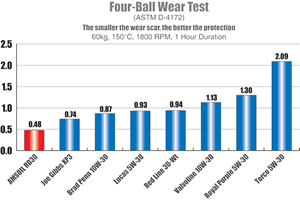 Royal Purple 5W-20 vs AMSOIL RD20 5W-20
Royal Purple 5W-20 vs AMSOIL RD20 5W-20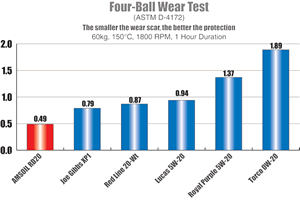
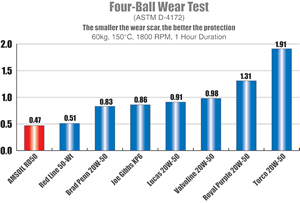
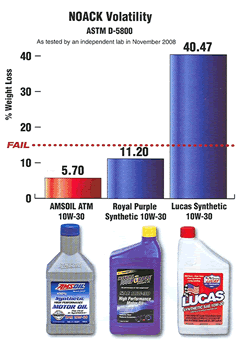 AMSOIL was the first motor oil company in North America to use the NOACK volatility test to measure motor oil quality and performance. Although competing motor oil companies initially paid no attention to NOACK results, the test has since become a critical measurement tool throughout the industry.
AMSOIL was the first motor oil company in North America to use the NOACK volatility test to measure motor oil quality and performance. Although competing motor oil companies initially paid no attention to NOACK results, the test has since become a critical measurement tool throughout the industry.
Originally developed and used in Europe, the NOACK volatility test determines how much weight an oil loses through volatilization. The more a motor oil vaporizes, the thicker and heavier it becomes, contributing to poor circulation, reduced fuel economy and increased oil consumption, wear and emissions.
During the test, the subject oil is heated to 302 degrees Fahrenheit (150 degrees Celsius) for a specified period, causing the lighter oil molecules to boil off. The results are reported in the percentage, by weight, of the oil that evaporates. The lower the number, the better the oil resists volatilization.
Because they are made from impure, irregular molecules, conventional motor oils are more susceptible to the effects of heat. The small, light molecules in conventional oil tend to evaporate (volatilize) as the oil is heated, leaving large, heavy molecules behind and leading to oil consumption and an increase in the oil’s viscosity (thickening). If those large, heavy molecules are chemically unstable, they may also break down and form deposits on component surfaces, further inhibiting the release of heat into the oil stream.
Because their formulations minimize the quantity of impure, irregular molecules, synthetic motor oils are generally more resistant to volatilization, allowing them to perform better than conventional oils in the NOACK volatility test. However, due to varying qualities of base stocks and additives, not all synthetic motor oils perform the same in the NOACK test.
Modern engine designs generate more heat than ever, accentuating the importance of the NOACK volatility test for determining an oil’s ability to provide an adequate level of protection and performance. More horsepower, turbo chargers and aerodynamic styling have created extremely hot environments that receive less cooling from outside air, and high heat leads to oil oxidation, deposits and thickening in conventional oils.
Because AMSOIL synthetic lubricants contain only uniform molecules, they are much more resistant to thermal and oxidative breakdown. AMSOIL synthetic motor oils help keep components free of damaging varnish, deposits and sludge.
Top quality for the current API SM motor oils specification, gasoline motor oils cannot experience a weight loss of more than 15 percent in the NOACK test. AMSOIL Synthetic Motor Oils were exceeding modern requirements over 20 years ago, while many current motor oils still have a hard time meeting this minimal requirement, increasing wear, fuel consumption and emissions.
As seen in the graph, AMSOIL 10W-30 Synthetic Motor Oil (ATM) easily passes the NOACK Test and falls well below the maximum 15 percent volatilization (burn off) rate dictated by the API SM motor oil specification, while the Royal Purple volatilization (burn off) rate is over 11 percent and the Lucas Oil FAILS the test with a volatilization (burn off) rate of over 40 percent.
In 2013 AMSOIL again compared Royal Purple along with 9 other brands. For full report refer, 2013 synthetic oil comparison test results page
New York, NY – April 1, 2009 – The National Advertising Division (NAD®) of the Council of Better Business Bureaus has recommended that Royal Purple, Ltd., modify or discontinue certain advertising claims for it's synthetic motor oil.
NAD, the advertising industry's self-regulatory forum, examined comparative performance and superiority claims in print, broadcast and Internet advertising, following a challenge by BP Lubricants.
Claims at issue included:
In its decision, NAD noted that the advertiser voluntarily agreed to discontinue the claims “most advanced,” “unsurpassed performance” and “unparalleled performance,” steps that NAD found were necessary and proper to avoid confusion in the marketplace NAD noted that it appreciated the advertiser’s participation in the NAD process, especially as a newcomer to the retail automotive industry as it branches out from industrial lubricants. Further, NAD noted that testimonials included in a wide range of auto-enthusiast publications indicate that Royal Purple’s consumers are “vocally appreciative of its synthetic purple engine oil.”
However, NAD noted, anecdotal evidence based solely on the experiences of individual consumers is insufficient to support product efficacy claims, including claims related to horsepower, torque, fuel economy or engine heat. While the advertiser may quote from published articles if it provides clear and conspicuous attribution to the publisher, it may not rely on such articles to support efficacy claims for which it has no reliable independent validation.
Following its review of the non-anecdotal evidence in the record, NAD recommended that the advertiser discontinue the claims “Reduces emissions up to 20% or more.” and “Reductions in emissions of 20% or more” because the studies on which the claims were based are outdated and not consumer-relevant.
NAD recommended that the advertiser discontinue its unsupported claim that Royal Purple motor oil is “API/ILSAC Certified.”
Royal Purple, in its advertiser’s statement, said it “appreciates NAD’s review of the extensive record in this matter as well as the NAD’s recognition of the difficulty the automotive industry has with accurately quantifying performance claims based on bench tests alone as they do not accurately reflect real world results.”
The company noted that, while it believes the “tests and testimonials it supplied as evidence accurately portray the benefits of using its synthetic oil in a wide variety of applications, it defers to the NAD’s position that those tests and testimonials alone are insufficient to support specific performance attribute claims in consumer advertising.”
The company noted, as well, that it has “already made changes to its advertising in accordance with the NAD recommendations and will continue to implement NAD’s recommendations and analysis in developing Royal Purple’s future advertising.”
NAD's inquiry was conducted under NAD/CARU/NARB Procedures for the Voluntary Self-Regulation of
National Advertising. Details of the initial inquiry, NAD's decision, and the advertiser's response will be
included in the next NAD/CARU Case Report.
Royal Purple Ltd. was black and blue after BP Lubricants USA took it to task over advertising claims for its synthetic motor oil, finding a receptive audience in the advertising industry’s self-regulatory forum.
The National Advertising Division of the Council of Better Business Bureaus recommended Porter, Texas-based Royal Purple modify or discontinue numerous advertising claims for its synthetic motor oil, following a challenge by Wayne, NJ based BP Lubricants. The NAD examined comparative performance and superiority claims in print, broadcast and Internet advertising. In some of the advertising, Royal Purple compared its performance to Castrol, Shell, Amsoil and other motor oil brands.
NAD recommended that Royal Purple discontinue its use of consumer testimonials reporting specific performance attributes in the absence of reliable independent evidence showing performance capability.
“Anecdotal evidence based solely on the experiences of individual consumers is insufficient to support product efficacy claims, including claims related to horsepower, torque, fuel economy or engine heat,” the organization stated. “While the advertiser may quote from published articles if it provides clear and conspicuous attribution to the publisher, it may not rely on such articles to support efficacy claims for which it has no reliable independent validation.”
NAD recommended Royal Purple discontinue claims such as “Increases horsepower and torque by as much as 3 percent,” “Reduces Engine Wear by 80 percent,” “Superior Oxidation Stability” and “Provides Film Strength Up to 400 Percent.”
“If industry-standard tests or tests with carefully documented controls were abandoned, there would be no basis whatsoever for making any meaningful claims about the relative efficacy of motor oils,” BP said in its challenge.
NAD recommended that Royal Purple discontinue claims that stated, “Improves fuel economy by as much as 5 percent” and “Fuel economy improvement up to 5 percent or more” because its Environmental Protection Agency testing was inconclusive and the “Oklahoma State Study” and single cylinder Labeco CLR diesel engine testing cited in Royal Purple’s advertising was not relevant. The NAD noted the 1997 OSU Study was “outdated and nothing in the record demonstrated that the formulations of the competitors’ oils were similar to those available for sale on the market today.”
BP Lubricants said it hired the independent laboratory Southwest Research Institute, in San Antonio, to analyze power output of gasoline engines with Royal Purple Oil and with BP’s Castrol oil for comparisons. “The results were provided to the challenger’s expert statistician who was not informed of the identity of the candidate oils,” NAD stated. “The challenger’s [BP’s] expert determined a 0.9 percent difference in power between the oils, which did not rise to the level of statistical significance, and is well below the 3 percent claim made by the advertiser.”
SwRI did additional tests to independently determine the differences in fuel economy, emissions data and engine temperature between Royal Purple and Castrol motor oils. According to SwRI, “there was no statistically significant difference between the fuel economy, emissions data or engine temperature between the two candidate oils,” NAD said.
Following its review of the non-anecdotal evidence in the record, NAD recommended that Royal Purple discontinue the claims, “Reduces emissions up to 20 percent or more” and “Reductions in emissions of 20 percent or more” because the studies on which the claims were based were outdated and not consumer-relevant.
NAD also recommended the advertiser discontinue its unsupported claim that Royal purple motor oil is “API/ILSAC Certified.” Noting that API and ILSAC licenses and certifications have many categories with different meanings, the NAD recommended that the company discontinue its claim that its synthetic oils are “generally ‘API/ILSAC Certified.’”
In fact, no Royal Purple products are certified to current ILSAC specifications.
The American Petroleum Institute licenses its trademarked Service Symbol, or ‘donut,’ for display on qualified engine oils, and also licenses the ILSAC ‘star burst’ logo for oils that meet the auto industry’s latest energy-conserving standards. In API’s online directory of licensees for its Engine Oil Licensing and Certification Program, Royal Purple has a total of 23 passenger car and diesel engine oil products listed, all licensed to use the API donut. Five of these may additionally display the words ‘energy conserving’ within the donut logo, but none of the Royal Purple products are licensable to the current ILSAC GF-4 specification and they cannot display the star burst logo.
Royal Purple also voluntarily agreed to discontinue the claims, “most advanced”, “unsurpassed performance” & “unparalleled performance” steps the NAD said were necessary and proper to avoid confusion in the marketplace.
“While Royal Purple also believes that the tests and testimonials it supplied as evidence accurately portray the benefits of using its synthetic oil in a wide variety of applications, it defers to the NAD’s position that those tests and testimonials alone are insufficient to support specific performance attribute claims in consumer advertising,” the company said in its response to NAD. “... [Royal Purple] has already made changes to its advertising in accordance with the NAD recommendations and will continue to implement NAD’s recommendations and analysis in developing Royal Purple’s future advertising.”
BP Lubricants did not return phone calls from Lube Report requesting comment on NAD’s decision.

Reviewed by Farmer BoostB18c BokChoy: 
Good to know info. I'm a hardcover Royal Purple oil fan. Yes I grew up using Amsoil first. I didnt know there was this much problem with the texas brand. Amsoil has come up with some new oils while RP's technology has little new products. I hope to stop using RP....and start to buy more other oil brands. May God help me. Thank you for publishing this article. I'm a well missed informed consumer. I lost a Differential to RP's gear lube 75W140 because the machine was on for 12 hours. I will keep trying others oil.
Re: Not bad
Thanks for sharing your experience with RP. AMSOIL focuses on producing oils that perform well in all area. Well rounded oil is crucial for a balanced and long service life for both the oil and the equipment. Focusing on just one or few performance criteria's can have serious long term failures. Such approach may be suited for racing or other targeted application. Replied by Tech Admin
Reviewed by Marty: 
I have used AmsOil Transmission fluid exclusively in my 2008 Dodge
Ram 6.7 cummins 6speed automatic transmission since new. I tow heavily weekly with this truck and have 457,000 miles on the original transmission. If that isn't proof enough of what a superior product AmsOil is I don't know what would ever convince you...
Reviewed by Frank: 
wheres GTX, Quaker State, Mobile 1, Shell Rotella just to name a few. I recognize the common names in the bogus graph study. The other ones are who???? Not in most Stores.
Re: Red What???? Joe Who??? Torrco huh??
1) The title of this article says it all "AMSOIL vs Royal Purple"
2) The comparison study is between 50w racing oils and not oils like GTX, Quaker etc...
3) We have published other comparison studies in these categories.
4) AMSOIL does not publish bogus data.
Replied by Tech Admin
Reviewed by C.R.H.: 
I have always been in search of high quality oils, grease and filtration for maintenance/servicing my equipment i.e. trucks, cars and others... I always thought that r-purple was one of the best oils on the market. if this information is true. I was wrong... I have used AMSOIL in the past, but find other oils much easier to find. I generally purchase my oils and filters from the local NAPA store, the NAPA gold and platinum filters rank very high in quality, and they have a large selection of quality oils to choose from... [I have not run into AMSOIL at NAPA]
I generally purchase my oils and filters a day before I do the maintenance on my equipment.
question: is AMSOIL stocked on the shelf at local stores, or only through distributors?
Re: maintenance master...
Thank you for considering AMSOIL for your maintenance. Yes, AMSOIL is the pioneers in synthetic technology, first in the world (since 1972) and still the best in quality and performance.
AMSOIL dealers and retailers generally carry fast moving items. When it comes to filters, there are 100's or even 1000's of part numbers making it difficult to keep them in stock.
The best way to buy them is to become a preferred customer (left menu) and buy direct from the factory (25% off MSRP). Products for California will be shipped from our Nevada distribution center. Replied by Tech Admin

 Canada
Canada United States
United States
Reviewed by Asad Murtaza:
Owner
We,AXCL Gulf ,hv a blending plant in UAE ,producing commercial / industrial lubes for 30 years. Royal Purple lubes are popular in the region with their Synthetic lubes & they hv recommendations from major engine manufacturers. We also buy their product for reselling thru their agent in UAE. Do you hv similar range of products & also recommendations from engine manufacturers.If you think your product can offer good competition please advise. We will be interested to promote your company !